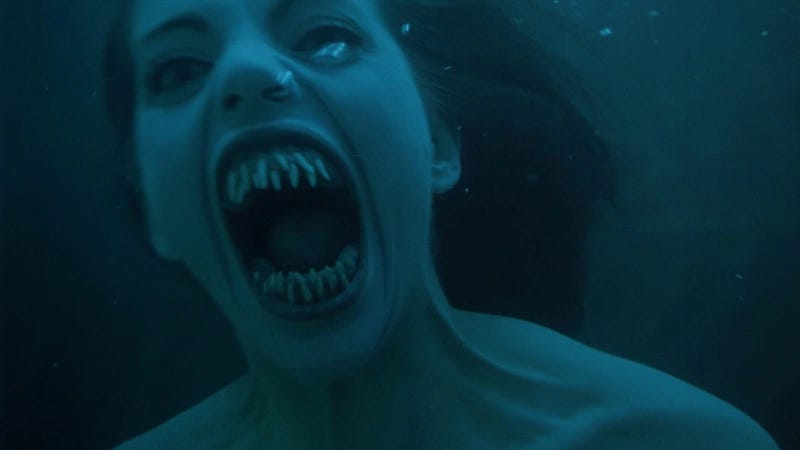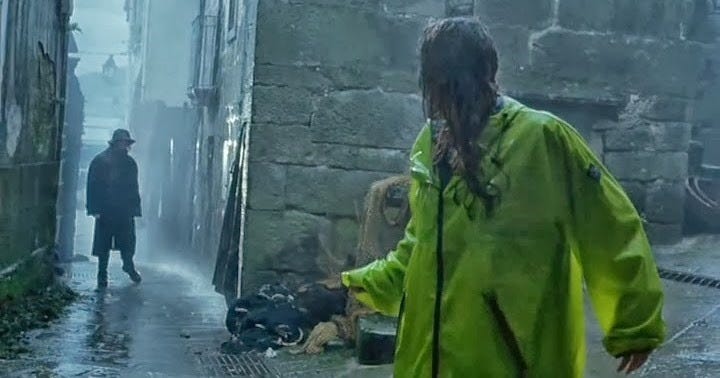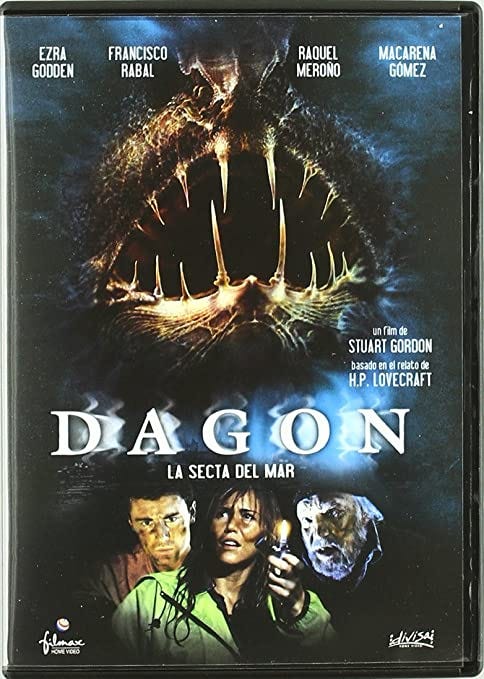Dagon: secta del mar, Comfort of My Childhood in 7 Minutes.
Snuggle into my mind with a quick read about an incestuous sci-fi film on my 29th birthday.
“We shall dive down through black abysses—and in that lair of the Deep Ones we shall dwell amidst wonder and glory forever.” —HP Lovecraft
My grandfather and I used to watch scary movies.
Sci-fi movies too (and thrillers) at any rating, G through R—together. His love for horror movies became my love for horror movies, and that love has shaped my personality in lasting ways.
He died two years ago.
Modern horror movie plots are like fast-moving highways riddled with potholes. The fact that my grandfather is dead is as real to me as any hastily added, minor event in a horror movie plot. I don’t talk about it much. I rarely think about it or notice it—but it’s there, his death. It’s like my heart is a deep well, and he’s there at the bottom of it.
Stuart Gordon’s horror film, Dagon: la secta del mar (2001), a movie adapted from HP Lovecraft’s short story “Dagon” (1917), also has a considerably deep well that holds another type of death:
When my grandfather and I watched Dagon: la secta del mar together, I remember being soothed by the constant rain in the film’s background, the strange pagan symbols throughout, and the sound of Gallego drifting like a draft from cold mutant mouths.
Lovecraft was an American writer, known for shaping much of cosmic horror, extraterrestrial-infused narrative, and SyFy cinematic material. You name it in 2023—in the spooky, alien American context—Lovecraft has a hand in it (that’s gross conjecture—I’d have to write a book that proves that sentence is true, don’t take me so seriously).
When Lovecraft’s writing “Dagon” in 1917, Woodrow Wilson’s declaring war on Germany for the first time, it’s WWI, and neither of us existed.
I’ve never read Lovecraft’s version, but Gordon’s story creates the world of a young American sailor and his girlfriend stranded at sea while yachting along the Spanish coast. Well before their boat crashes and they head out to sea in a life raft, he’s had a good amount of semi-erotic nightmares that include a brunette siren—yo—who later turns out to be his horny-for-him half-sister (yikes).
Sirens, if you’re curious, probably were very real, very voluptuous Greek sea-lady monsters, who sang so seductively that men used to jump ship deep at sea to follow their voices. It’s unclear by most credible accounts if sirens sleep with sailors, but it’s very clear that the sailors always drown after that melodious call reaches their ears.
Nah^^, this isn’t a siren lo0l, or a character from Dagon: la secta del mar —this is Daryl Hannah in Splash (1984) (fkn check it out), another film my grandfather and I loved.
In any case, our American sailor finds refuge on an island town, Imboca, filled with strange inhabitants who look and feel uncomfortably aquatic. There, he eventually stumbles upon a well to the ocean’s underworld—a gate to the ancient world of Dagon: a dreadful sea monster whose worshippers inevitably become part of the sea themselves.
For Lovecraft and Gordon, death is just one door that leads to many.
Dagon’s door happens to lead to many different types of glorious immortality according to his high priestess:
Para las personas jóvenes españolas de alma vieja, ya verán que la sacerdotisa es Macarena Gomez, una homie real, actriz potente en el cine español actual y la chica de mis sueños eróticos y ciencia-ficciones (pondría fantasías). Yo tenía entre 7 y 10 años cuando la vi por primera vez en esta actuación. Ahora me doy cuenta de que no entendí que la adaptación era internacional y más allá incluso se trataba de una colaboración española-estadounidense. Qué ironía. Es muy probable que aparecieran subtítulos cuando la película se retransmitió, y la joven Olivia ni pudiera leerlos suficientemente bien y rápido para captar lo que estaba sucediendo lingüísticamente.
Linguistically-speaking in the film, we see one American English speaker, one bilingual speaker of Spanish and English (the American’s girlfriend, naturally) and an isolated Galician community speaking both—in addition to what’s probably Gallego (spoken by Spanish actors from Barcelona)—despite their being shunned by the mainland.
None of these Imboca motherfuckers care in the slightest that they’ve been rejected by humanity—they have no interest in the human or the humane. When they were human, many years before our sailor barrels into their reality, they were a fishing community—not unlike mine. But while my community thrived and thrives on American middle and upper-middle-class tourism, Imboca thrived on fish. When the sea yielded no fish, and Imboca’s inhabitants looked around at one another starving and sopping desperation, the town turned away from God and toward Dagon. Upon this turning, fish appear.
Gold appears!
Scales appear.
Jump-to-conclusion: I think that Lovecraft’s “Dagon” is a story about suicide prompted by the moral ugliness of the world. I think that Gordon’s film is about accepting that every well has a bottom, an end—even if that end is unending.
Anyway, through the reconstructed story made for the screen, we see many a budding-talented, bilingual cast of humble beginnings appearing to make modern in 2001 what was once a hit-clip classic of 1917. Dagon: la secta del mar appeared on the American television channel SyFy sometime between 2001 and 2004 when I saw it with my Poppy and later forgot it.
Like the most important lessons from WWI (a generational core memory) and your fuck-ups (personal core memories), and everything else we experience when we’re little that makes us who we are and is then subsequently erased from our memories by our memories, Dagon: Secta del Mar (my core memory) was forgotten one summer night shortly after I saw it.
I’ve thought of the memory of the film randomly every year for the past ten or so years—more frequently since my Poppy passed. I tried so many times to remember the name, the characters, the scenes—anything I could feed to Google—another type of lesser god, in hopes that the sacrifice of my reaching into the darkest depths of my watery mind could dredge up precious gold—or a fish, a memory, creative sustenance.
I remembered that people were hobbling along on stilts through sunken flooded streets when I’d root around the storage bins of the attic in my head. I sent Google, millions of microscopic robotic spiders crawling at the speed of light across an endless web, to hunt for “flooded rainy town people on stilts movie” several times. You can imagine how broad and unhelpful the results were.
Of course there were no stilts—just the extended, tentacle limbs of people hobbling around with aquatic deformities. All I had was a deformed memory of the film on loop for years.
Yet for months now I've wanted to cram Google into my looper mind to decipher the swollen, bloated, fuzzy memory.
I wanted to say “Hey Google, they claim you know everything. Do you know my m i n d? Can you crawl through the web of my m i n d?—root through the crevices of my m i n d and extract this movie right—n o w.”
The frustration, bro—at not being able to remember what made me so me.
You see: Dagon: la secta del mar is the first science-fiction film I can remember watching with my grandfather. It’s the opening to the well of my mind. It’s precious, prayed-for, like bulging nets of fish in famine.
It’s the movie that catalyzed the creation of my mind as a fantasy factory.
The Sea God Resurfaces On a Saturday
It was last Saturday, just days before my 29th birthday, that I saw the film fill out on my Netflix feed and, at first, I flew past it. Then, something called me back to it. It took 20 minutes or so of watching to confirm that this was the one.
That this B-rate film has found its way back to me—that this 69er of a Rotten Tomato movie has reappeared in my life—is right on divine-intervention-time. It’s my grandfather: my past: it’s Spain: my present: it’s death: my future. It’s everything! It’s this rambling blog on my 29th birthday.
It is the fish I prayed for—the jump and the jumper cables that rebooted my brain's creative battery (I haven't written like this since COVID quarantine).
While I love to see limbs ripping, faces torn off, giant squid sea gods impregnating human women—all cinematically portrayed of course (I’m normal)—what I love more is feeling, through the screen, nostalgia—and the gap between young me and me now—and how there is no gap at all.
In conclusion, death is a just door that leads to many—much like this blog will.
Subscriptions, Subscribing, Etc..
Substack advises that, at some point, I explain what this blog will do, how often it will do it, and how it benefits you—and that I should call you to action with a button like this one:
I have no idea what the f00k you’d be subscribing to. It could be any of the following:
Diary-like entries from your favorite nearly-30 rando
Content that involves horror films and personal anecdotes
Confessions of real feelings and opinions that I have in my waking life
My dreams, which may or may not be a direct hotline to the Almighty (more on this in future content)
Written versions of my podcast (it’s not yet been recorded)
Content that involves music from across the globe
Content in Spanish (jaja), Portuguese (kkk), and English (lol)
Dark, scary, problematic shit unabashedly shared
Many of the things I think God tells me to tell you
Politics, feminism, heartbreak, gossip, etc.
The benefits that you reap from consuming this information? Maybe like:
You get a breakdown of daily life and culture as experienced by a smart, small-town girl in a global environment
You get exposure to thousands of cultural threads that may push you into creative spaces you didn’t even know you occupied
You can take my life as a flexible blueprint for yours (mentor/mentee)
You get me
Follow @livicarus on Instagram For Updates
Eventually, there’ll be a podcast coming and this platform will mutually support it—probably on Thursdays around 4PM EST. So if you’re nosy, bored, or curious: sígueme y te proporcionaré cosillas culturales y entretenidas—pero apenas.










